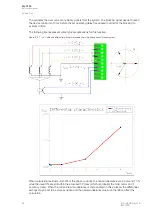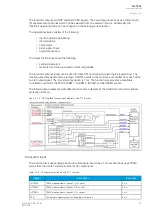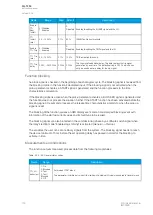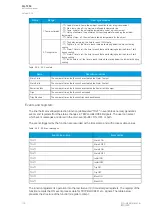
The function registers its operation into the last twelve (12) time-stamped registers. The table below
presents the structure of the function's register content.
Table. 5.3.8 - 74. Register content.
Date and
time
Event
HV L1
current
HV L2
current
HV L3
current
LV L1
current
LV L2
current
LV L3
current
dd.mm.yyyy
hh:mm:ss.mss
Event
name
HV side's
Phase L1
current x I
n
HV side's
Phase L2
current x I
n
HV side's
Phase
L3 current x I
n
LV side's
Phase
L1 current x I
n
LV side's
Phase L2
current x I
n
LV side's
Phase
L3 current x I
n
5.3.9 Transformer thermal overload protection (TT>; 49T)
The transformer thermal overload protection function is used for monitoring and protecting thermal
capacity in power transformers.
The function constantly monitors the instant values of phase TRMS currents (including harmonics up to
31
st
) and calculates the set thermal replica status in 5 ms cycles. The function includes a total memory
function of the load current conditions according to IEC 60255-8.
The function is based on a thermal replica which represents the protected object's or cable's thermal
loading in relation to the current going through the object. The thermal replica includes the calculated
thermal capacity that the "memory" uses; it is an integral function which tells this function apart from a
normal overcurrent function and its operating principle for overload protection applications.
The thermal image for the function is calculated according to the equation described below:
Where:
• θ
t%
= Thermal image status, percentage of the maximum available thermal capacity
• θ
t-1
= Thermal image status, previous calculation cycle (the memory of the function)
• I
max
= Measured maximum of the three TRMS phase currents
• I
N
= Current for the 100 % thermal capacity to be used (pick-up current in p.u., t
max
achieved
in τ x 5)
• k
SF
= Loading factor (service factor), maximum allowed load current (in p.u.) value,
dependent on the protected object or cable/line installation
• k
amb
= Temperature correction factor, either from a linear approximation or from a settable
ten-point thermal capacity curve
• t = Calculation time step (0.005 s)
• e = Euler's number
• τ
1
= Thermal heating time constant of the protected object (in minutes)
• τ
2
= Thermal heating time constant of the protected object (in minutes)
The basic operating principle of the thermal replica is based on the nominal temperature rise, which is
achieved when the protected object is loaded with a nominal load in a nominal ambient temperature.
When the object is loaded with a nominal load for a time equal to its heating constant tau (τ), 63% of
the nominal thermal capacity is used. When the loading continues until five times this given constant,
the used thermal capacity approaches 100 % indefinitely but never exceeds it. With a single time
constant model the cooling of the object follows this same behavior, the reverse of the heating when
the current feeding is zero.
A
AQ
Q-T256
-T256
Instruction manual
Version: 2.06
94
© Arcteq Relays Ltd
IM00028
Содержание AQ-T256
Страница 1: ...AQ T256 Transformer protection IED Instruction manual...
Страница 2: ......
Страница 264: ...Figure 7 3 120 Example block scheme A AQ Q T256 T256 Instruction manual Version 2 06 262 Arcteq Relays Ltd IM00028...
Страница 284: ...Figure 8 13 141 Device installation A AQ Q T256 T256 Instruction manual Version 2 06 282 Arcteq Relays Ltd IM00028...
















































